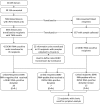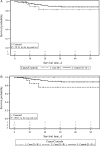Transfusion-Transmitted Dengue and Associated Clinical Symptoms During the 2012 Epidemic in Brazil
- PMID: 26908780
- PMCID: PMC4747611
- DOI: 10.1093/infdis/jiv326
Transfusion-Transmitted Dengue and Associated Clinical Symptoms During the 2012 Epidemic in Brazil
Abstract
Background: A linked donor-recipient study was conducted during epidemics in 2 cities in Brazil to investigate transfusion-transmitted (TT) dengue virus (DENV) by DENV RNA-positive donations.
Methods: During February-June 2012, samples were collected from donors and recipients and retrospectively tested for DENV RNA by transcription-mediated amplification. Recipient chart review, using a case (DENV positive)-control (DENV negative and not known to be exposed) design, was conducted to assess symptoms.
Results: Of 39 134 recruited blood donors, DENV-4 viremia was confirmed in 0.51% of donations from subjects in Rio de Janeiro and 0.80% of subjects in Recife. Overall, 42 DENV RNA-positive units were transfused into 35 recipients. Of these, 16 RNA-positive units transfused into 16 susceptible recipients were identified as informative: 5 cases were considered probable TT cases, 1 possible TT case, and 10 nontransmissions. The TT rate was 37.5% (95% confidence interval [CI], 15.2%-64.6%), significantly higher than the viremia rate of 0.93% (95% CI, .11%-3.34%) in nonexposed recipients (P < .0001). Chart review did not find significant differences between cases and controls in symptoms or mortality.
Conclusions: During a large epidemic of DENV-4 infection in Brazil, >0.5% of donations were RNA positive, and approximately one third of components resulted in TT. However, no significant clinical differences were evident between RNA-positive and RNA-negative recipients.
Keywords: NAT; clinical symptoms; dengue; transfusion-transmission.
© The Author 2015. Published by Oxford University Press for the Infectious Diseases Society of America. All rights reserved. For permissions, e-mail journals.permissions@oup.com.
Figures



Comment in
-
Dengue Virus and Blood Transfusion.J Infect Dis. 2016 Mar 1;213(5):689-90. doi: 10.1093/infdis/jiv322. Epub 2015 Jun 8. J Infect Dis. 2016. PMID: 26908779 No abstract available.
Similar articles
-
Duration of Dengue Viremia in Blood Donors and Relationships Between Donor Viremia, Infection Incidence and Clinical Case Reports During a Large Epidemic.J Infect Dis. 2016 Jul 1;214(1):49-54. doi: 10.1093/infdis/jiw122. Epub 2016 Apr 1. J Infect Dis. 2016. PMID: 27302934 Free PMC article.
-
Dengue viremia in blood donors identified by RNA and detection of dengue transfusion transmission during the 2007 dengue outbreak in Puerto Rico.Transfusion. 2012 Aug;52(8):1657-66. doi: 10.1111/j.1537-2995.2012.03566.x. Epub 2012 Feb 17. Transfusion. 2012. PMID: 22339201
-
Probable and possible transfusion-transmitted dengue associated with NS1 antigen-negative but RNA confirmed-positive red blood cells.Transfusion. 2016 Jan;56(1):215-22. doi: 10.1111/trf.13288. Epub 2015 Sep 7. Transfusion. 2016. PMID: 26469514
-
Urgent Alert: Potential Risk of Dengue Infection Transmission Through Blood Transfusion in Iran.Arch Iran Med. 2024 Dec 1;27(12):693-699. doi: 10.34172/aim.31756. Epub 2024 Dec 1. Arch Iran Med. 2024. PMID: 39891457 Free PMC article. Review.
-
Dengue viruses in Brazil, 1986-2006.Rev Panam Salud Publica. 2007 Nov;22(5):358-63. doi: 10.1590/s1020-49892007001000009. Rev Panam Salud Publica. 2007. PMID: 18198045 Review.
Cited by
-
Viral metagenomics in blood donations with post-donation illness reports from Brazil.Blood Transfus. 2021 Mar;19(2):93-101. doi: 10.2450/2020.0027-20. Epub 2020 Jul 22. Blood Transfus. 2021. PMID: 33000756 Free PMC article.
-
Dengue virus serological markers among potential blood donors: an evidence of asymptomatic dengue virus transmission in Cameroon.Pan Afr Med J. 2020 Jul 14;36:185. doi: 10.11604/pamj.2020.36.185.22128. eCollection 2020. Pan Afr Med J. 2020. PMID: 32952829 Free PMC article.
-
Transfusion-transmitted arboviruses: Update and systematic review.PLoS Negl Trop Dis. 2022 Oct 6;16(10):e0010843. doi: 10.1371/journal.pntd.0010843. eCollection 2022 Oct. PLoS Negl Trop Dis. 2022. PMID: 36201547 Free PMC article.
-
MVSE: An R-package that estimates a climate-driven mosquito-borne viral suitability index.Methods Ecol Evol. 2019 Aug;10(8):1357-1370. doi: 10.1111/2041-210X.13205. Epub 2019 Jun 19. Methods Ecol Evol. 2019. PMID: 32391139 Free PMC article.
-
Zika and chikungunya virus infections in hematopoietic stem cell transplant recipients and oncohematological patients.Blood Adv. 2017 Apr 10;1(10):624-627. doi: 10.1182/bloodadvances.2016003285. eCollection 2017 Apr 11. Blood Adv. 2017. PMID: 29296705 Free PMC article.
References
-
- Bianco C. Dengue and Chikungunya viruses in blood donations: risks to the blood supply? Transfusion 2008; 48:1279–81. - PubMed
-
- Chuang V, Wong TY, Leung YH et al. . Review of dengue fever cases in Hong Kong during 1998 to 2005. Hong Kong Med J 2008; 14:170–7. - PubMed
-
- Holmes EC, Twiddy SS. The origin, emergence and evolutionary genetics of dengue virus. Infect Genet Evol 2003; 3:19–28. - PubMed
-
- Mackenzie JS, Gubler DJ, Petersen LR. Emerging flaviviruses: the spread and resurgence of Japanese encephalitis, West Nile and dengue viruses. Nat Med 2004; 10:S98–109. - PubMed
Publication types
MeSH terms
Substances
Grants and funding
LinkOut - more resources
Full Text Sources
Other Literature Sources
Medical

